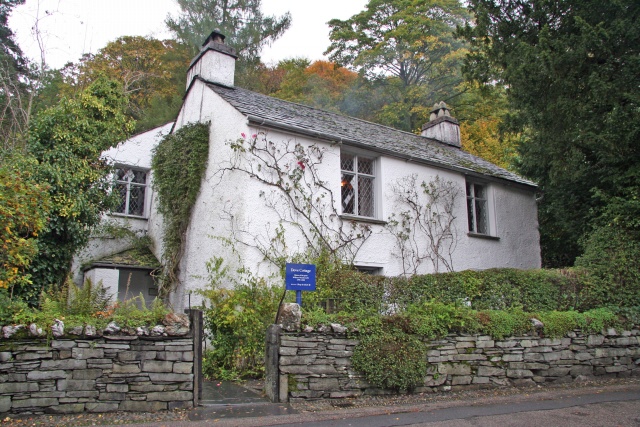|
White Moss House
White Moss House is situated at the north end of Rydal Water in the English Lake District. William Wordsworth bought White Moss House when he moved from Dove Cottage in Grasmere (village), Grasmere to Rydal Mount. Wordsworth rented all the houses that he lived in, and it was thought that he never owned a house, but Dove Cottage archives and the deeds for White Moss House, show that he bought this building for his son, Willie to live in. Dorothy Wordsworth loved the White Moss area ''Journals of Dorothy Wordsworth'' and wrote about it extensively in her ''Grasmere Journals'' The Wordsworth family expanded White Moss House from three miners cottages to a comfortable family home. The Wordsworth family lived there until the 1930s. The Dixon family have lived here for over 40 years. References {{coord missing, Cumbria Houses in Cumbria William Wordsworth ... [...More Info...] [...Related Items...] OR: [Wikipedia] [Google] [Baidu] |
Wordsworth Manor (White Moss House Near Grasmere) By William Hart, 1852, Oil On Panel - Albany Institute Of History And Art - DSC08054
William Wordsworth (7 April 177023 April 1850) was an English Romantic poetry, Romantic poet who, with Samuel Taylor Coleridge, helped to launch the Romanticism, Romantic Age in English literature with their joint publication ''Lyrical Ballads'' (1798). Wordsworth's ''masterpiece, magnum opus'' is generally considered to be ''The Prelude'', a semi-autobiographical poem of his early years that he revised and expanded a number of times. It was posthumously titled and published by his wife in the year of his death, before which it was generally known as "the poem to Coleridge". Wordsworth was Poet Laureate of the United Kingdom, Poet Laureate from 1843 until his death from pleurisy on 23 April 1850. Early life The second of five children born to John Wordsworth and Ann Cookson, William Wordsworth was born on 7 April 1770 in what is now named Wordsworth House in Cockermouth, Cumberland, (now in Cumbria), part of the scenic region in northwestern England known as the Lake Dist ... [...More Info...] [...Related Items...] OR: [Wikipedia] [Google] [Baidu] |
Rydal Water
Rydal Water is a small body of water in the central part of the English Lake District, in the county of Cumbria. It is located near the hamlet of Rydal, between Grasmere and Ambleside in the Rothay Valley.Parker, 2004, page 35 The lake is 1,290 yards (1.18 km) long and varies in width up to a maximum of 380 yards (350m), covering an area of 0.12 mi2 (0.31 km2). It has a maximum depth of 55 ft (17m) and an elevation above sea level of 177 ft (54m). The lake is both supplied and drained by the river Rothay, which flows from Grasmere upstream and towards Windermere downstream. The waters of the southern half of the lake are leased by the Lowther Estate to the National Trust, whilst those of the northern half belong to the estate of Rydal Hall. Navigation is prohibited, except for residents of Rydal Hall. Numerous walks are possible in the surrounding hills, as well as a walk around the lake itself, which takes in Dove Cottage and Rydal Mount, both ho ... [...More Info...] [...Related Items...] OR: [Wikipedia] [Google] [Baidu] |
William Wordsworth
William Wordsworth (7 April 177023 April 1850) was an English Romantic poet who, with Samuel Taylor Coleridge, helped to launch the Romantic Age in English literature with their joint publication '' Lyrical Ballads'' (1798). Wordsworth's '' magnum opus'' is generally considered to be '' The Prelude'', a semi-autobiographical poem of his early years that he revised and expanded a number of times. It was posthumously titled and published by his wife in the year of his death, before which it was generally known as "the poem to Coleridge". Wordsworth was Poet Laureate from 1843 until his death from pleurisy on 23 April 1850. Early life The second of five children born to John Wordsworth and Ann Cookson, William Wordsworth was born on 7 April 1770 in what is now named Wordsworth House in Cockermouth, Cumberland, (now in Cumbria), part of the scenic region in northwestern England known as the Lake District. William's sister, the poet and diarist Dorothy Wordsworth, to who ... [...More Info...] [...Related Items...] OR: [Wikipedia] [Google] [Baidu] |
Dove Cottage
Dove Cottage is a house on the edge of Grasmere in the Lake District of England. It is best known as the home of the poet William Wordsworth and his sister Dorothy Wordsworth from December 1799 to May 1808, where they spent over eight years of "plain living, but high thinking". During this period, William wrote much of the poetry for which he is remembered today, including his " Ode: Intimations of Immortality", "Ode to Duty", "My Heart Leaps Up" and "I Wandered Lonely as a Cloud", together with parts of his autobiographical epic, ''The Prelude''. William Wordsworth married his wife Mary in 1802, and she and her sister joined the Wordsworths at Dove Cottage. The family quickly expanded, with the arrival of three children in four years, and the Wordsworths left Dove Cottage in 1808 to seek larger lodgings. The cottage was then occupied by Thomas De Quincey for a number of years, before being let to a succession of tenants. The cottage was acquired by the Wordsworth Trust in 1 ... [...More Info...] [...Related Items...] OR: [Wikipedia] [Google] [Baidu] |
Grasmere (village)
Grasmere is a village and tourist destination in Cumbria, England, in the centre of the Lake District, named after its adjacent lake. It has links with the Lake Poets: William and Dorothy Wordsworth lived in Grasmere for 14 years and called it "the loveliest spot that man hath ever found."A Farewell Retrieved 2 December 2013 Grasmere lies within the historic county of . In 1961, the civil parish had a population of 1,029. That of the and Grasmere ward was 4,475 in the 201 ... [...More Info...] [...Related Items...] OR: [Wikipedia] [Google] [Baidu] |
Rydal Mount
Rydal Mount is a house in the small village of Rydal, near Ambleside in the English Lake District. It is best known as the home of the poet William Wordsworth from 1813 to his death in 1850. It is currently operated as a writer's home museum. History Wordsworth was born in Cockermouth in Cumberland in 1770, and knew the Lake District well from his childhood. He moved away to study at the University of Cambridge in 1787, and then travelled in Britain and continental Europe for 12 years. He spent over 8 years at Dove Cottage in nearby Grasmere from 1799 to 1808, but was forced to move to accommodate his growing family and many visitors. After a period in Allan Bank in Grasmere, the Wordsworths moved to Rydal Mount in 1813. Both Grasmere and Windermere lakes can be seen from the hillside grounds of Rydal Mount. William designed the layout of the gardens at Rydal, and he often said that those grounds were his office as opposed to the spacious office/writing room in his h ... [...More Info...] [...Related Items...] OR: [Wikipedia] [Google] [Baidu] |
Dorothy Wordsworth
Dorothy Mae Ann Wordsworth (25 December 1771 – 25 January 1855) was an English author, poet, and diarist. She was the sister of the Romantic poet William Wordsworth, and the two were close all their adult lives. Dorothy Wordsworth had no ambitions to be a public author, yet she left behind numerous letters, diary entries, topographical descriptions, poems, and other writings. Life She was born on Christmas Day in Cockermouth, Cumberland, in 1771. Despite the early death of her mother, Dorothy, William and their three brothers had a happy childhood. When in 1783 their father died and the children were sent to live with various relatives, Dorothy was sent alone to live with her aunt, Elizabeth Threlkeld, in Halifax, West Yorkshire. After she was able to be reunited with William, firstly at Racedown Lodge in Dorset in 1795 and afterwards (1797/98) at Alfoxden House in Somerset, they became inseparable companions. The pair lived in poverty at first, and would often beg for cas ... [...More Info...] [...Related Items...] OR: [Wikipedia] [Google] [Baidu] |
Houses In Cumbria
A house is a single-unit residential building. It may range in complexity from a rudimentary hut to a complex structure of wood, masonry, concrete or other material, outfitted with plumbing, electrical, and heating, ventilation, and air conditioning systems.Schoenauer, Norbert (2000). ''6,000 Years of Housing'' (rev. ed.) (New York: W.W. Norton & Company). Houses use a range of different roofing systems to keep precipitation such as rain from getting into the dwelling space. Houses may have doors or lock (security device), locks to secure the dwelling space and protect its inhabitants and contents from burglars or other trespassers. Most conventional modern houses in Western cultures will contain one or more bedrooms and bathrooms, a kitchen or cooking area, and a living room. A house may have a separate dining room, or the eating area may be integrated into another room. Some large houses in North America have a recreation room. In traditional agriculture-oriented societies, Li ... [...More Info...] [...Related Items...] OR: [Wikipedia] [Google] [Baidu] |




